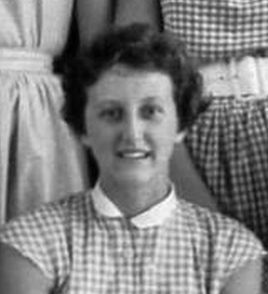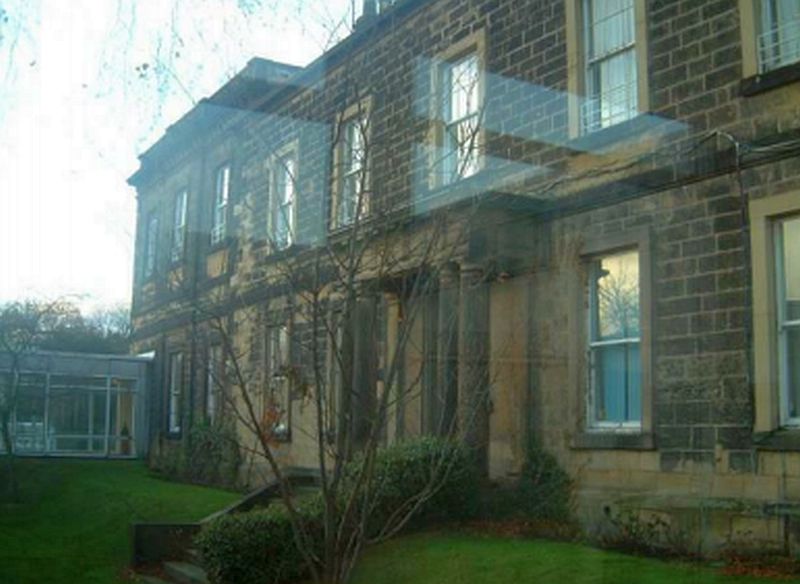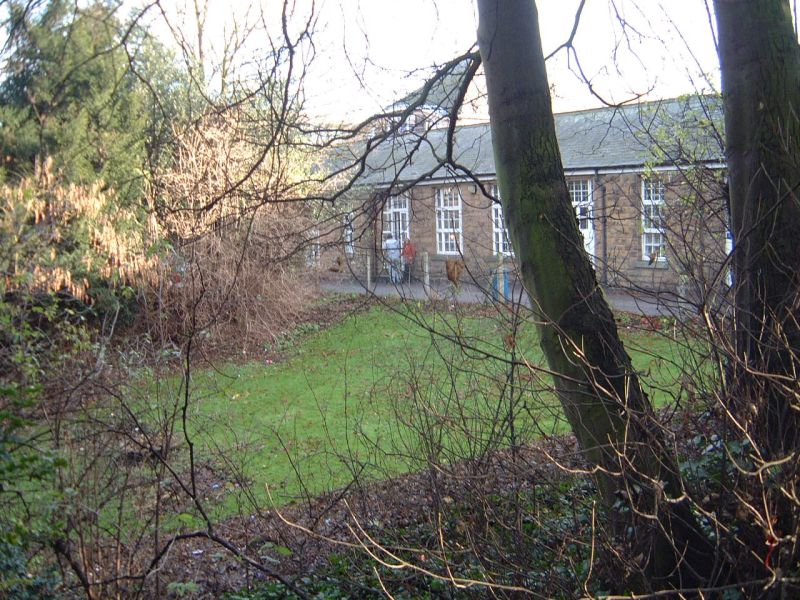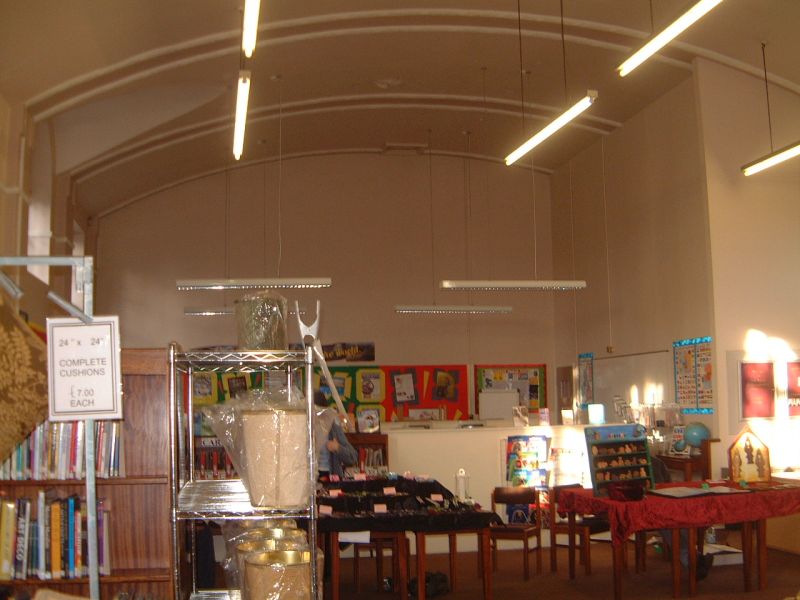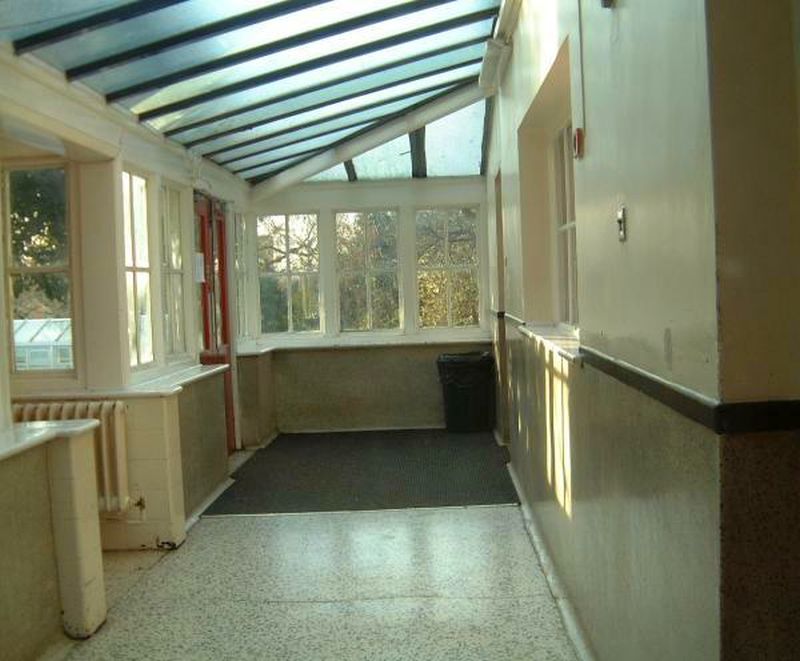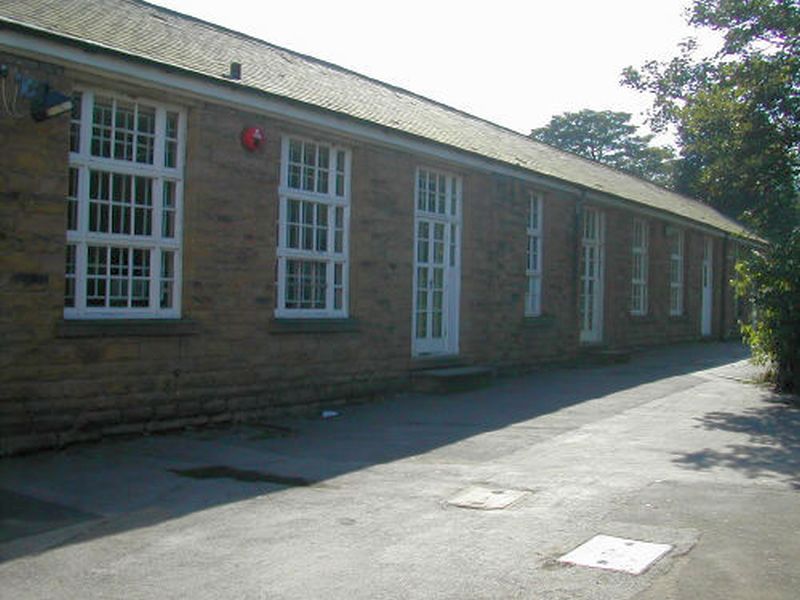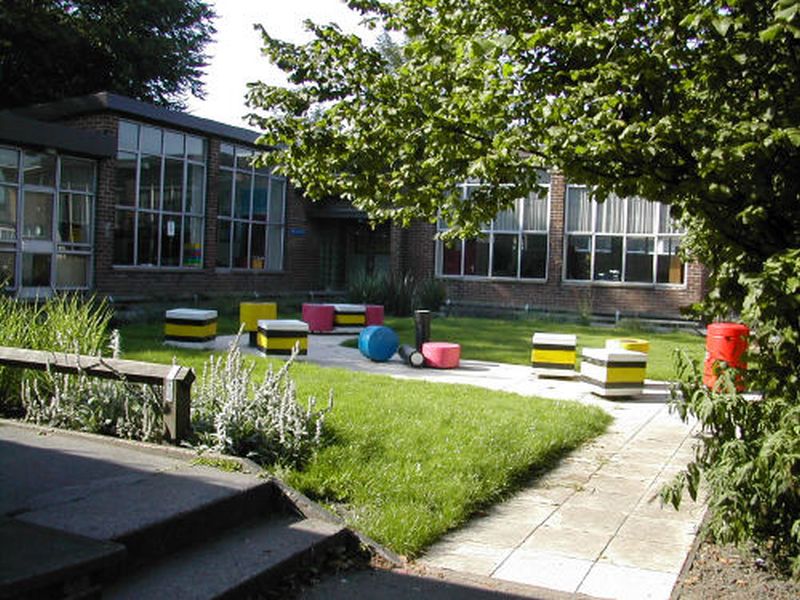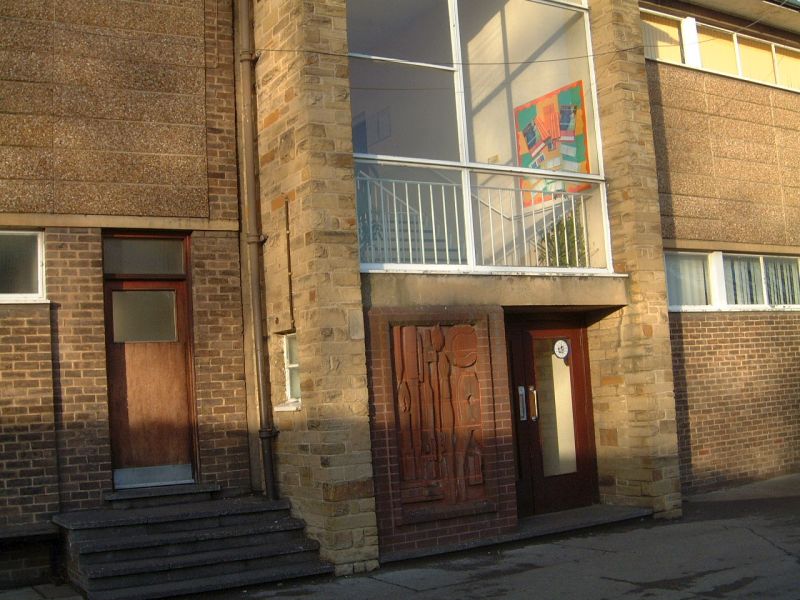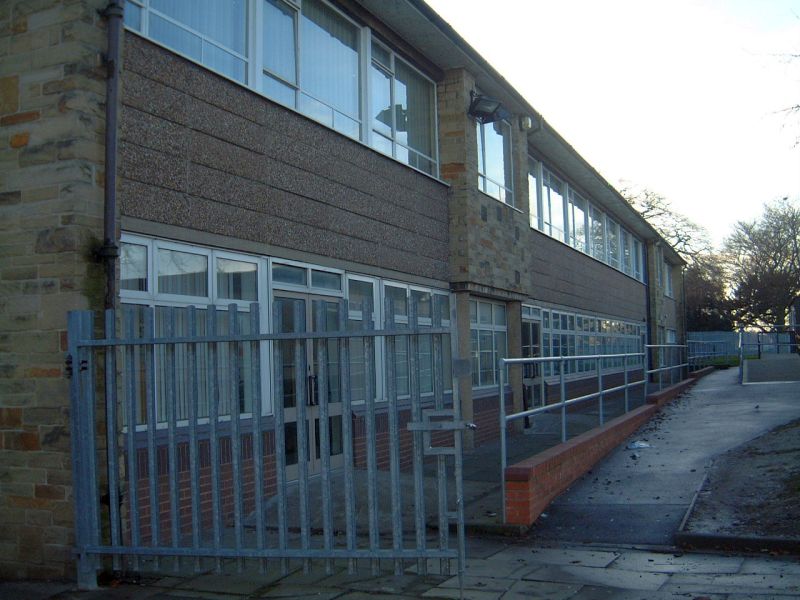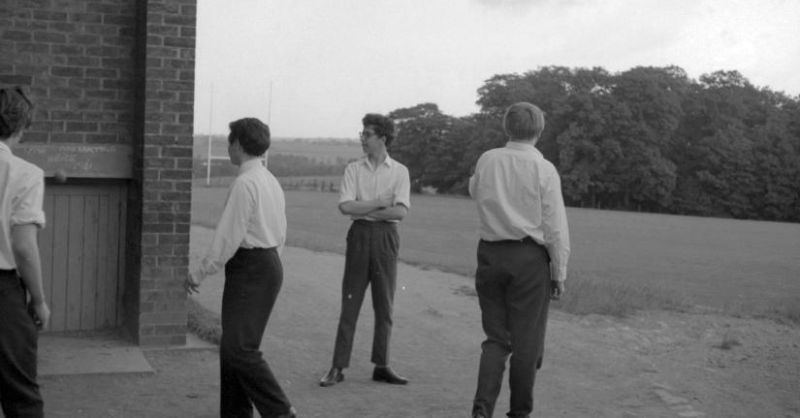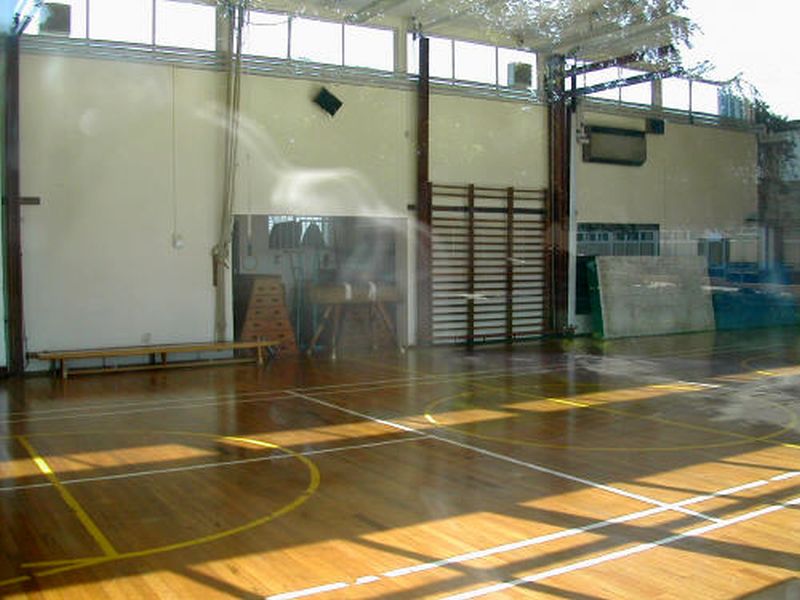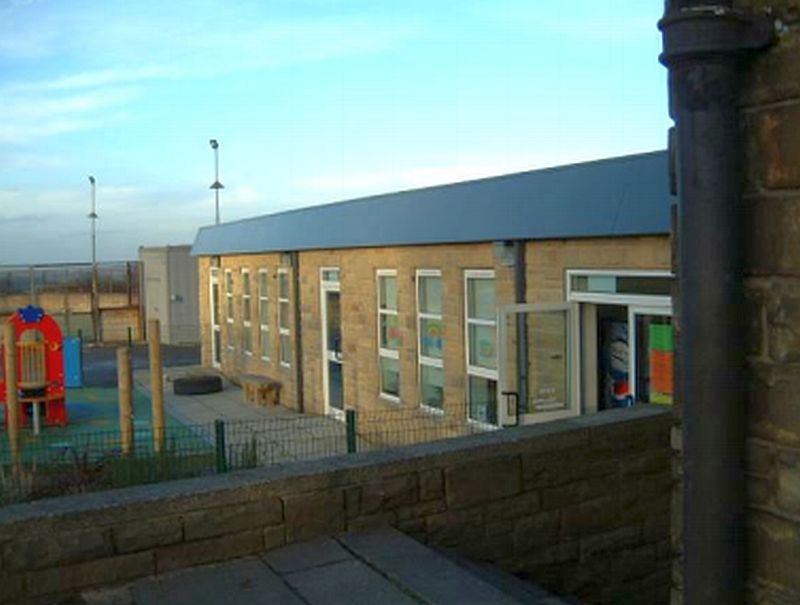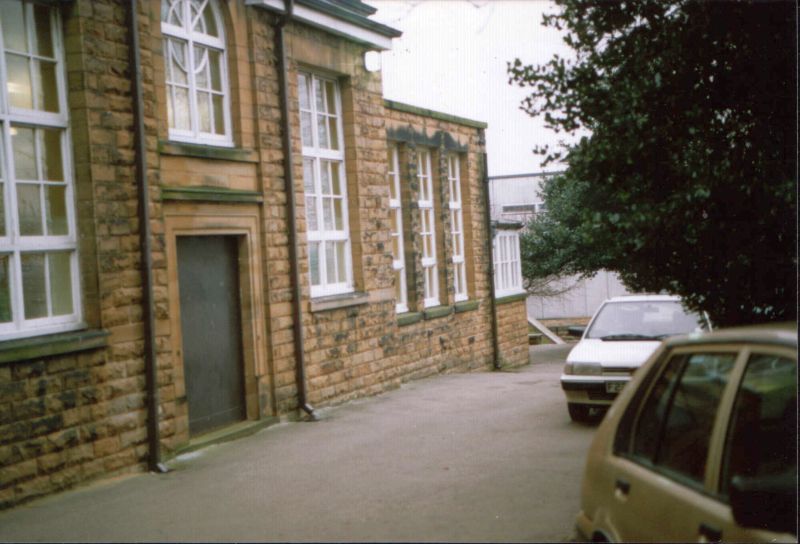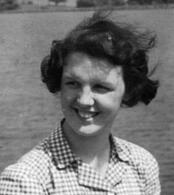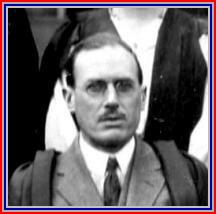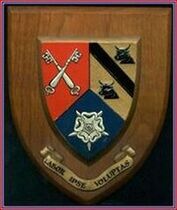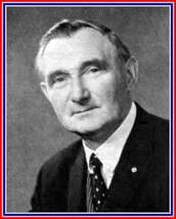Have you been back?
A visit to the HHS Craft Fair in November 2003
A visit to the HHS Craft Fair in November 2003
Sheila Kelsall
On the 30th November 2003 a Craft Fair was held at our old School. A corridor has been created from the vicinity of the Boys’ entrance. It extends the corridor running down from the old Needlework room of 1955-62 days, and leads to that “unsympathetic building” (Leighton) which mars the front elevation of the School. I had assumed that the old main entrance near the Head’s study had been used for access to the new building - but no, all is undisturbed, as you can see. The gravel and the small set of steps to the left of the main steps are gone, as is the flagpole. I had to take the photo through the glass window of the corridor, but still managed to notice that the destructive ivy had rallied and was on its way back up the wall on the far side. Access was denied to the part of the old building which runs from the boys’ entrance along past the Head’s study and Prefects’ rooms towards the girls’ cloakroom, but I did look along there, and noticed that the stone steps of the main staircase are gone, and metal-edged uniformly-sized risers and treads had replaced them. In every other classroom of the old part of School there were stalls selling a selection of handicrafts. Particularly noticeable were the efforts of the College’s Rural Studies Department - holly wreaths, houseplants and succulents for sale lined the whole length of the top corridor, and a group of friendly young people were doing good business taking customers on a tour of the Rural Studies centre.
I was interested in seeing the alterations previously photographed by Glenn Riley. I drove into the main entrance on Station Road, and upwards into an overspill car park which was a grassy area at the side of some tennis courts which I decided had been laid over the old kitchen garden, Girls’ Arch and Fives Court. Much of my subsequent visit was spent with my eyes closed, working out what used to occupy the area I could see when I opened them! Standing at the side of my car, I looked around me, and recognised the Head’s house, with its surrounding beech hedge. The familiar stone side of the Main Hall lay unchanged to my left, but beyond the Head’s house and down the slope of the Girls’ Walk there were several houses which seemed to continue down to the main road and then along it towards the church. There was surprisingly no trace of the Girls’ Walk itself.
Seeking the entrance to the building, I approached the Dell. Autumn’s untidiness lay all around, with the bonus of a clear view through the bare trees. Another surprise came with the sight of four-feet-high concrete posts and chain-link wire mesh fencing which lined the edge of the path running along the outside of the Domestic Science room and ran along the back of the New Block. The words “ugly” and “not in keeping” sprang to mind. Did the Dell always seem so shallow? In my memory it had a steeper slope and the grass disappeared into dappled, then impenetrable shade. I suppose nearly 50 years worth of annual leaf-mould had raised the ground level since then! There did not seem to have been any effort made to collect the dead leaves, which along with ivy and other evergreens covered the stone sides of the dell, and camouflaged the sandstone behind. I looked across at the back of the New Block and noticed a twisted, distorted tree trunk clinging to the rocky side and showing clear signs of human misuse. A blue nylon rope hung in tatters from a couple of places on the trunk, and suddenly I wanted to move away from the atmosphere of sadness and violation there. Now, where was that entrance?
“This is a new way into School”, I thought. I had just spent a few minutes at the side of the Dell, lost in a strange dimension of swirling remembrances bridging the last forty years, but it was now time to enter the building. When I was at HGS in the late 50’s and early 60’s, if one walked to the outside through any of the Hall doors and turned right, away from the Girl’s cloakroom entrance, then at the end of the side wall of the Hall there was a widening of the path, and on the right, one could then see the stonework of the side of the Domestic Science Room. I recall there was a low stone wall to the left, which formed an edging for the rhododendrons and other shrubs which grew there. In the right-angle formed between the Domestic Science wall and the wall behind the Hall stage, as it were, there were doors which were rarely opened. They provided access to a storeroom which lay between the rear of the Hall and the aforesaid Domestic Science room. Could this have been where the P.E. crash mats were stored? I do not remember ever seeing either of the sets of doors to this area open.
I found myself inside School, looking back along the storeroom and marvelling at how wide and deep it was. Suddenly, in one downward glance, the familiarity of my schooldays returned with a bump! The black mottled specks on the marble floors and the occasional crack which ran from one side to the other; the black border along the sides of the floors; the steps down to the lower level of the Hall corridor; the cupboard at the side of the Hall where as an Assistant Prefect I had kept my books, and the glass cases on the top of these cupboards, which I remember as being empty, but lined with faded blue sugar paper - all were there in front of me! By now I was heading into the Hall, and my first major shock. They say that when a place is visited which has been familiar in one’s childhood, it usually appears to be smaller. In this case, the Hall floor space is actually so. During our Assemblies, the lower forms of the School stood in lines near the front of the stage, and so it went that the older the children were, the nearer the Honours Boards at the back they stood. The boys occupied the half of the Hall on the Quad side, and the girls stood nearer to the outside doors, leaving a central aisle about a yard wide. I looked up and noted the fluorescent lighting strips. As pupils, we had individual lights there with white fluted shades. I remembered the domed, cylindrical ceiling, similar to that of the Dining Hall, with its decorative plaster ridges, and the way that it was shaped to take account of the high windows. I had gazed up there many times looking for inspiration during the Test Exams and G.C.E’s! There were also those periods of boredom during Assemblies. “In the name of the Father, and of the Son and of the Holy Ghost, Amen” I heard echoing down the half-century. “Our Father, who art in Heaven, Hallowed be Thy name.......” was our daily morning prayer. I looked down at the carpeted floor, and pictured the herringbone parquet which I assumed lay beneath. In preparation for the Prefects’ Dances we used to sprinkle talcum powder on it to ensure ‘slide’. At the beginning of each School year, at our first Assembly we all encountered a newly polished expanse of this patterned wood, demonstrating the care and attention bestowed upon it by the caretaker and his staff, no doubt. I wondered if the recesses which ‘located’ the bolts on the wall bars were still there. When swung out into the room at right angles to the walls, they and the climbing frame were steadied by this method. As I approached the exit door, I saw on the wall to my right, six wooden-framed photos of how the School used to look. “Time to see if the Girl’s Cloakroom is still there!” I thought, as I went through the door and turned right.
Having absorbed the changes in the School Hall since I was last there in 1962, I headed for a look at the Head’s study and Prefects’ Rooms. With the quad to my left, I approached the right-angled, left-handed corner just past the back doors of the Hall. There’s a boring bit of corridor about twelve feet in length which has plain walls and ceiling and the same marble floor that ran all around the Quad. Further along on the right are the doors through which all the girls usually entered the “temple of learning” that was School. I remembered that going left there, towards the Main Staircase, one encountered a different atmosphere. It was darker; there were more doors right and left, and above all, the sound of one’s footsteps changed. At busy times, here the pupils’ feet had made a thunderous sound, because the floors were wooden. This area formed the original part of the building, and cellars probably lay beneath. Any further progress I had in mind was curtailed by a large sign forbidding access. That part of the building was not being used for the Fair, so I stood there and brought to mind the countless young people - including myself - who had walked the fairly short distance from the Head’s study to the Hall along that very route, quaking in their boots - for two reasons. First, it was unlikely that anyone had previously accompanied the Head on a walk of any length, much less with the eyes of the assembled School upon them, and this, together with the probable one-to-one chat with the Head while walking, would have kept many a pupil awake the night before. The second reason for the nerves would have been the prospect of reading the lesson during Assembly in front of eight hundred or so of one’s peers. I didn’t know too many people who would have enjoyed this without the trepidation!
A one hundred and eighty degree turn brought me to the doors of the Girls’ Cloakroom. They were locked, but just look at the photo! A wider doormat and a bin in the corner - that’s all the difference I could see from the days of forty-odd years ago! I don’t know whether the cloaks area is now used for the same purpose. It is unlikely that today’s students would place a hat, coat and scarf on a peg with a pump bag beneath as we did, and be able to rely on it’s being undisturbed until the end of the day. I remember seeing the occasional pump bag thrown onto the shelf on the right after it had been found in the wrong place, or had been dropped on the floor elsewhere. Those sensible rounded joints between floor and wall were just as I remembered them all along the Quad corridors too, and that tiled dado was always painted black. The single-glazed windows used to steam up when the conditions were right, giving opportunity for some transient graffiti (usually a heart with an arrow through it and initials) and I recall that on very cold winter days the radiator was very popular! I decided it was time I retraced my steps along past the Hall if I wanted to see more of the Fair and School.
Standing at my point of entry into School - the old store cupboard door behind the stage in the Hall, I looked down the full length of the corridor which had provided access to the Domestic Science Room, the Physics Room and the Music Room of my Schooldays. Tables were arranged along the length of the right-hand-side of the corridor, and contained hundreds of potted plants and seedlings which were being offered for sale by the Rural Studies Department of the College. Holly wreaths stood on the windowsills, and hung from hooks in the woodwork of the windows, and of course, many other visitors were milling around me.
I was interested to see the Quad. Gone were the paths leading to Wendy and the weather station. Now why should that be? Ease of mowing? Change for change’s sake? I wonder. A sad and stagnant small “pool”, presumably intended to be decorative, was situated in the grassed area at the corner near the Domestic Science room, and around it was growing a collection of conifers which probably had looked quite attractive a few years ago when first planted, but which were now too close together, and had outgrown the space available. More importantly, they restricted the view from that side of the building; they restricted the light available within the building, and their roots will no doubt pose a threat to those marble corridors if they are allowed to grow unchecked. Definitely a “thumbs down” from me for this ill-judged garden makeover! Surely the Quad is not a modern garden, and should have retained its more formal arrangement to be sympathetic to its surroundings! So much could have been added to this area to enhance its original formal concept, instead of ‘dumbing it down’ and then neglecting it. Come back Wendy! - where are you?
True to tradition, the Domestic Science Room of my long - gone Schooldays was being used for refreshments on the day I visited. I could hear cup - on - saucer noises amid the sounds of conversations, and could see a busy cafe scene of people, chairs and tables as I stood at the door. At the next doorway along there was a table across the entrance of what seemed to be a small storeroom, and soup was being sold there in polystyrene cups. I found the Middle Classroom of that wing was so different from my memory of it as to be unrecognisable. When Mr. Farrar took us for General Science there in the ‘50’s, there was a raised plinth at the front of the room with either a bench or a teachers’ desk upon it, and a blackboard which slid up and down on rollers at top and bottom. I recall that one of the sections contained squares painted on it in a grid formation. The surface available on which the teacher could chalk his information could be moved by grasping a horizontal metal strip on the board and pushing it upwards or downwards. Diagrams and homework assignments appeared there, and sometimes a previously prepared set of questions could be wound round from the rear of the board after the initial verbal introduction had been delivered. The necessary blackboard equipment was usually nearby - chalks both coloured and white, and board rubbers, which were felt pads stuck onto a wooden piece of wood about six inches long and one and a half inches wide. The back of the wooden part of the rubber (which was where one held the item to rub out the chalk marks) was not flat, but had a ‘dip’ in it running lengthwise, and rounded edges for ease of gripping. The felt of the ones which had been in use a long time became worn down at one end, and sometimes the rubber became so clogged with chalk that it needed tapping against an outside wall to clear it. I remember the felt pads always had a black or grey striped layer or two in the central area - a bit like a sandwich filling. Black was usually the colour of the boards in every classroom at the beginning of each School year, due to the cleaners or the caretaker washing them down during the long Summer holiday. As the terms progressed, the became greyboards, really.
Benches containing Bunsen Burners and their gas taps ran sideways-on to the windows, which overlooked the Dell. Drawers and cupboards lay beneath them, and as they were higher than normal desks, stools instead of chairs were provided. The floor was untreated floorboards and the ceilings high and white. Was there a poster of a Valence Table hung on one of the walls? Certainly there were no examples of the pupils’ work there. Our Exercise Books contained all the evidence of our academic labours, which were first honed to perfection in our Rough Books - or not, in many cases! So, what of the room’s appearance nowadays? One sees carpeted floor, lowered suspended ceiling, fluorescent lights, no plinth, no blackboard, and notice boards at the front and back of the room containing displays of children’s work. It is a multi-purpose space, and on that day, there seemed only myself, the windows, the French Doors and the view outside to bear witness to its origins.
On to the Music Room. Although I have memories of Miss Carter and her Music lessons, they were not connected to this room, but were given to the classes of my first-year in the classroom opposite the Head’s study. It was Mr. Boyd and Miss Evans who held Choir and Orchestra practices in this room. All the School’s classes had Music here at least once a week, and would sing, accompanied by the teacher on the piano which was wheeled out of the storeroom near the French windows. In there were kept the books and sheet music for the choirs, the musical instruments, the records and the gramophone player (West Riding Issue) with its plywood case and hinged lid. Unlike the other two rooms along this wing of the School, it had windows on three sides, making it seem bright, light and airy, somehow. The desks stood in rows, and were of a light-coloured wood, the floor was again, untreated floorboards. The blackboard was there, with its staves painted on in lines, and a teachers’ desk, from which the register was called during first lesson of the mornings and afternoons for the form which had the Music Room as its Form Room. I don’t ever recall anyone having the temerity to ‘bunk off’ lessons, though it may have happened. A high, white ceiling provided good acoustics, and the uplifting atmosphere of the room played its part in the many individual and joint achievements in the Music Concerts, House Competitions and performances on a wider stage. Could this be the same room? I saw a lowered, soundabsorbent squared ceiling and the all-pervading carpeted floor. What is this fascination for carpets in schools? They become unhygienic; require electricity to clean them properly; require regular expensive replacement and more importantly, seem to be an unspoken acknowledgement that young people can not control the way they move and speak so as not to disturb others. Today’s Music Room is another of those multi-use spaces which disappointingly lost all of its character and atmosphere when the carpet fitters and ceiling construction companies moved in. Sadly, the same story can be told of the other three classrooms leading down to the Boys’ Entrance. I came away from the classrooms feeling much the same as a time-traveller from the Shakers would, after being dumped into an over-stuffy, cluttered Victorian Drawing Room.
Where to next? As I was considering the options, my elbow was tapped by a smiling young pupil with a placard hanging from his neck stating "Rural Studies Guide". He offered me a guided tour of that Department for the sum of 50p. "Where do we go?" I asked. "Out there", the guide replied, nodding towards a door. After I paid the fee, three young people escorted me through the door by the Music Room which led out into the Boys' playground. I went down a set of steps near to where the loads of coke used to be tipped, and where you would be opposite the door to the 'Pound' in the wooden shed. Suddenly I found myself stunned by the view. The fairly small changes in the classrooms and Hall which I had noted in the previous few minutes paled into insignificance at the grossness of the sight before me. I was dumbfounded! Gone were the needlework room, the metalwork room, the pottery room, the woodwork room - in fact the whole Stable Block. I knew they had been demolished in 1967 after I read Terry's account of the changes made to greet the Comprehensive regime. That was not the cause of my utter horror. It was the sheer overwhelming size, shape and colour of their replacement which stopped me in my tracks. I stood with sagging jaw as my guides marched on ahead of me, oblivious to my frozen amazement. Within a few yards of where I stood, an enormous concrete structure blocked out the sky. Ugly girders shamelessly displayed themselves alongside the stonework of the existing building from which I had just emerged. Huge, blank sheets of glass formed the windows of this graceless block, but worst of all, the whole thing seemed to be painted BRIGHT RED! At this point I would love to be able to say - "Just look at the photo!" but I could not bring myself to click the camera button. I had the option on my camera's memory card to take many more pictures, yet I could not bring myself to capture this horrendous scene for the life of me! It was as though someone had parked an enormous ocean liner within yards of the school - a red one at that!!
I swivelled round to get my bearings. Was there anything nearby which I could recognise? Ah yes, there was the New Block and the side of the Dining Hall. I scurried away from the scene of my shock towards the buildings in which I had spent my initial year of secondary education in 1955-56. There I found that what had been a neat lawn in front of the Tuck Shop now had paving, with Liquorice All Sorts blocks to act as seats. Trees of some maturity stood near to the Dining Hall side doors, and wooden low railings bordered the edge of that central area. It seemed to me that a plain and simple area of the school had been cluttered by shrubs, concrete, bark chippings and eye-catching structures, though I am sure there are those who would maintain that it is now more interesting. Still, the buildings of the New Block seemed the same, although the red ocean liner had extended itself up to the original main doorway of the Dining Hall, covering most of the playground there. As I turned away to pursue my 'guides' who were, by now, approaching the Science Block, I noticed that an outside light had been left on which was illuminating the doorway of the Tuck Shop. Was it fanciful that somehow, that light seemed significant at the time?
On familiar ground, I walked alongside my guides towards the Science block. I had never really studied the back of the kitchens, but they seemed much the same to me in 2003 as they were in the 1950's. Being in the 'Arts' stream from the fourth form onwards, I only ever entered three rooms in the Science Block - the Biology and Chemistry labs. and the Lecture theatre. The Science block was newly built back then, so we were fortunate that all the furniture and equipment there was new. In my third year, Mr. Dudley Taylor introduced 3A to the delights of Chemistry, in an upstairs classroom in the Science block, with long benches, stools, and a raised area at the front. Equations were announced, recorded and promptly forgotten by me during that year, along with the method of producing several gas jars of oxygen in the laboratory, and the definitions of an acid, a base and a salt. Diagrams of how I would obtain a pure crystalline specimen of copper sulphate starting from copper oxide went from the blackboard into my Rough Book and from there into my exercise book without any dallying within my memory. 31% in the end of year exam steered me away from the Science stream of the Fourth year.
My fourth year's General Science included a term or two with Biology's Mr. Kenneth Sale, who taught us, among many other things, the difference between palmate and pinnate leaf formation. He also communicated to me his love of his home county of Herefordshire, which he pronounced Haarfodshah. Photosynthesis, plant reproduction and the nitrogen cycle were all studied in this ground floor laboratory, where such a pleasant atmosphere prevailed that I looked forward to the lessons, and in the end of year mixed-discipline exam, I chose as many Biology questions as I could. The Lecture theatre was different from any other room in School. Wooden tiered seating either side of a central aisle took the shape of pews, with a small ledge at the rear of each bench upon which books could be rested by the pupils sitting behind. High windows precluded any distractions from outside, and the new furniture and floor were nicely varnished and of a light-coloured wood. No MDF here! The blackboard had a white section which could be rolled around to form a screen for the showing of films such as 'The Circulatory System', or 'Reproduction of Mammals' when the short curtains had been drawn across the windows. During either our fourth or fifth year, Mr. Whittaker took a Sociology lesson here each week, with the Science and Arts streams joining together, but not really sitting together. Each Friday after lessons ended, the Friday Club used the Lecture Theatre for a variety of activities. Visiting speakers; debates; poetry readings; travelogues and film shows served to broaden the minds of those who voluntarily attended.
These were the memories which I was carrying with me as I approached the Science Block. As I passed the glass entrance doors pictured above, I remembered the posters I used to be called upon to create, in order to advertise forthcoming Friday Club activities. Norman Hughes and myself used to take turns each week to paint or sketch something meaningful on the posters which would attract a large attendance and give the relevant title, date and time of the topic. One of the posters always used to be displayed on those glass doors, and the doorway to the Lecture Theatre lay beyond them, just to the right. I wondered whether the other side of the Science Block had undergone any changes. The photograph above shows that there is now a low wall with railings and a prison-like piece of metal fencing. In addition, there has been development at the base of the block indicated by the windows. In the days of the Grammar School, after 1957, this was a space which offered a good place to shelter when the weather was inclement.
Ahead of me stood the Caretaker's cottage, much the same as ever, but my powers of observation deserted me about the Pig Sties. A couple of my "Rural Studies Guides" were chatting to me about where we were heading, plus I was wondering if the Sports Hall round the corner to the left and up the steps would yield any surprises, and before I knew it, I was standing at the bottom of the said steps and had my back to the sties. Perhaps on a future visit I will remember to look right instead of left! "Come this way" said my young guide, and he indicated to me a completely new wide walkway laid at the side of the Sports Hall in a place I was unable to recall ever existed.
Every Hilmian of the era between 1957 and 1967 would remember standing at the bottom of the steps which led up to the higher level of the New Gym. The steps were wide, and situated at the gable end of the Science Block. On the right would be the Boys' Changing Room, and at the top of the concrete steps, also on the right, was another flight of stairs up to the Girls' Changing Room. The architects of the Science Block and the New Gym designed these two blocks on the 'modern' lines prevalent at the time, but with reference to the original buildings of the School. Sympathetic sandstone block walls did at least show a passing acknowledgement that these two buildings formed extensions to a much older building. The earlier New Block which housed the First Forms was a plain brick-and-glass utility extension which did nothing to enhance the nearby Main Block and Dining Hall, but was probably erected by means of a more frugal post-war budget. The photo above shows the area I have described, and here is a challenge I throw out to everyone - what would we have seen further to the right of this picture before 1967? (see photo below) My memory is a blank on this one, although I must have passed here hundreds of times! The caretaker's garden wall ended a little further to the right. What lay between this and the changing rooms all that time ago? At the present time, a pathway leads round to the rear of the Gym towards the Rural Studies area. The land sloped gently down until my guides and I found ourselves at our destination.
Here was a place to which I had no comparison from former times. I could not recall ever having been anywhere near this part of the School grounds - if indeed they belonged to School then. There was a quickening of interest from my guides, who enthusiastically guided me to the pigs' pen, a muddy area enclosed by a metre-high wire netting fence and with a shed at the far end. Four or five fairly small chocolate brown pigs came snuffling over to the gate where we stood, clearly expecting to be fed. They were hairy, agile and quite unlike any other pig I had seen. "What are these?" I asked, meaning what variety of breed. "Brown pigs," came the instant reply. I smiled, and asked if each one had a name. No, they did not, and would I like to see the goat? This friendly creature was housed in a similar pen with a shelter. We followed the paving-stone path past rabbits, guinea pigs and various other small animals which were happily enjoying the sunshine in their small enclosures.
Over to my right was a large greenhouse where students were busily assembling the holly wreaths which were on sale in the main building. A large number of the potted plants similar to the ones I had seen for sale in the top corridor were arranged on the staging, ready, I suppose, to replenish the stocks. Different people walked by, cradling mice and other small rodents. "Just taking so and so for some fresh air", I heard. The lady to whom these remarks were addressed came and chatted. I asked who fed the animals and birds during the holidays, and she said that either herself or a rota of dependable students attended to this. Even students who had left the School maintained an interest, and came to help, she assured me. My guides directed me to a temporary classroom with an open door. Inside, by the window, they showed me a large aquarium half-filled with water and containing so many bricks and breeze-blocks that there was hardly any swimming room for the two terrapins within. My first negative reaction was sympathy for these two creatures. Further along, a similar tank was used as a vivarium, where a mouse mother was sleeping with her week-old babies. A girl removed one of the babies and offered it to me to stroke. She said they started to handle the young ones as soon as they could, so they would be tame. All around the edge of the classroom were cages and tanks, and in the centre of the classroom were the usual desks, with a whiteboard at the front. Hens freely wandered in and out of the classroom without any extreme reaction from the people there, and the atmosphere was relaxed and caring.
My feelings during this visit to the Rural Studies centre were those of 'other-worldliness'. This was certainly an attempt to familiarise the students with rural life and care for animals, but I was left wondering how rural is Hemsworth life today, that a school should provide such a resource? The skill of caring for animals in today's society is a valuable one, and if such a department had existed when I attended HGS, I would have loved to spend time there, but it would have been a life-enhancing leisure activity and not a serious academic pursuit. Perhaps this small area of today's college is an example of the differences in approach to the education of young adults between a Grammar School and a Comprehensive. There are, after all, only so many hours in a day, and our timetables were geared towards less practical activities. Having thanked my guides, they drifted off to find further customers and I returned to the place pictured above, ready to climb those steps and see if the Gym and the playing fields had changed.
As I climbed the steps up to the level of the 'New' Gym, I was thinking of the number of young girls who had struggled down the stairs from the changing rooms on sunny afternoons with Rounders posts or sets of bats and balls, ready for a Games lesson, or a House or inter-School match. In summer they would have carried tennis racquets, rounders bats and balls or Athletics equipment, and in winter it would have been hockey sticks and netballs. All the equipment for these games was provided by School for the pupils, even the hockey boots, and stored in racks in a room at the far side of the changing room, next to the Games teacher's room. Do you remember all those coloured bibs and bands we used to wear as team identifications? Narrow strips of webbing sewn to make a circle, to be worn over one shoulder and across the torso, like a shoulder purse, would be handed out as sides were chosen. By now I had reached the windows of the New Gym, and as you can see from the photo, things have hardly changed at all within the building! As I gazed through the glass, I remembered the loud and echoing squeaks made by those black canvas pumps we used to wear, when the rubber soles connected at speed with the polished floor. Those distinctive piercing sounds were quite unique, and would still be recognisable to me, all these years later. When the 'New' Gym came into operation around 1957, the game of Basketball was introduced to us. The School Assembly Hall, where we had previously taken our PT lessons, had the stage at one end of the room, and so the requisite goal nets were an impossibility. Now, here were custom-built nets and a court marked out specifically for the game! The girls did not have a competitive team, but enjoyed playing basketball in the PT lessons. I think the boys were in a league. The New Gym floor was also marked out in various colours for badminton and netball. I remember that Miss. Musgrave insisted that she must be present in the New Gym before we entered, for obvious safety reasons, and sometimes we formed a hovering group by the door until she arrived.
I walked along the paving with the Gym's windows on my right, still marvelling at how little had changed inside since I left HGS in 1962. When I reached the end of the front elevation of the building, I came across a changed scene, new to me. I could not make out the purpose of the buildings which now sit on the 'new playground', where we all used to skip, chase, throw and catch, and of course, have our School panoramic photos taken. Was it a Nursery, or some sort of Day-care centre? The bright colours and outdoor play equipment hinted at this, or was it perhaps a remedial facility? My young guides were no longer accompanying me and there was no-one available nearby for me to ask. Maybe someone who reads this will be able to tell us. All the time I was walking, I could hear the voices of adults and young people shouting and encouraging the teams of footballers on the pitch nearby. I had seen that game in progress through the reflection of the glass in the windows of the Gym as I was looking inside the hall, but I had postponed turning round, reluctant to view what I feared would be a disappointment. The noises were loud, yet no one was anywhere near me. I suppose the sounds echoed against the buildings. I tried to get my bearings by identifying the trees, but it was a leafless November, and I was using a forty-year-old data base. Where was the mound with the large Horse Chestnut which used to stand by the running track? Where was the running track? Why could I see the rows of houses on the Kinsley road? Where was the North Walk? I could make out some Rugby posts on what used to be the Hockey pitch, and the football pitch of the game in progress which straddled the hallowed ground of our Cricket pitch. I wondered whether the present-day girl students were expected to play either of these two games, or whether Hockey pitches and Netball courts lay somewhere out of sight.
I try to be realistic about comparing my Schooldays with what is on offer today. I'm not one to say "everything was better in my day!", but as I gazed at the playing fields, I reflected that at no time when I attended HGS would I ever have been able to say that the playing fields looked like any local well-used park. Mr. Rhodes and his team put so much sterling effort into caring for our outdoor environment that the memory of this remains crystal clear all these years later, despite our taking it for granted at the time. Perhaps if I had had more time to linger, I may have found other unexpected counterbalances to the bleak scene before me, but I turned away, unwilling to look further, and saddened that strangers had spoiled something special. Back down the steps from the new gym I hurried, along by the back of the kitchens, and then between the Dining Hall and New Block I went, my eyes averting from the sight of the giant red carbuncle which had usurped the Stable Block and eaten up so much of the playground and sky around there. Should I re-enter the School through the door by the Music Room, or amble along by the side of the Dell? The Fair itself had become irrelevant, and as I had no further interest in joining the crowds, I walked along the deserted pathway, past the outside windows and doors of the Music Room, Science Room and Miss. Metcalfe's domain - the Domestic Science Room, all of which needed repainting. The next decision at the corner of the Domestic Science room, was should I go right or left? Right, as you may recall, would take me out to the playing fields and parking areas I had already seen, so I aimed for the side of the Hall, still marvelling that cars were allowed along there. The sun came out, and seemed to warm the sandstone walls of the Hall. I wondered about when it had been necessary to either replace or board over the original outside doors, and place wrought iron over some of the windows. A reflection of the times in which we now live.
There is a slight slope downwards towards the Girls' entrance which one can view in the photo by following the line of the bottom course of the stonework of the building. The washroom is still to be seen, though it may have another use today, and those outside toilets across from the Girls' entrance are long-gone, and certainly unlamented. Cold, draughty, and only to be used in dire emergency is my memory of those facilities! At this point I searched unsuccessfully for any sign of the Girls' Walk, but the corner of that "unsuitable" construction at the front of the main building had edged it out of existence. Yet just by the steps to the Girls' cloakroom, I discovered a low wall which seemed to have been undisturbed for half a century. It was topped by what seemed to me to be the very same smooth stone slabs where we had played our games when we were young. Knowing that holly is an extremely slow-growing tree, I imagined that those two trees by that stone wall had been there as seedlings since my schooldays. Who knows!
In reflective mood, I stood there, completely alone, and tried to rationalise all the new information I had experienced during that visit. It was an impossible task which is still unfulfilled. If anything could summarise my memories of that day, it would be the complete absence of birdsong in the area between the road and the buildings. There is nothing more to say.
Sheila Kelsall (Visit to the HHS Craft Fair Nov. 2003)
Sheila Kelsall (Visit to the HHS Craft Fair Nov. 2003)
Irene Wright
Dear Sheila,
I just had to say how much I enjoyed reading your account about your visit to our old school when you attended the Arts and Crafts Fair. My only regret on reading the account was that I was not there with you. I would have loved to have had a snoop around. I am so grateful for the web site, as it has enabled me to take a walk down memory lane, which physically I am unable to do, living so far away. I hope you and Dave realise how much pleasure your efforts have given to generations of Hilmians.
Many thanks.
Irene Wright HGS 1944-51
I just had to say how much I enjoyed reading your account about your visit to our old school when you attended the Arts and Crafts Fair. My only regret on reading the account was that I was not there with you. I would have loved to have had a snoop around. I am so grateful for the web site, as it has enabled me to take a walk down memory lane, which physically I am unable to do, living so far away. I hope you and Dave realise how much pleasure your efforts have given to generations of Hilmians.
Many thanks.
Irene Wright HGS 1944-51
